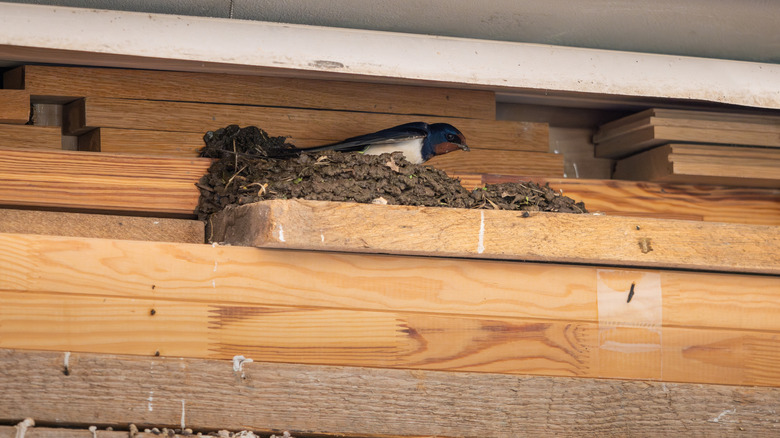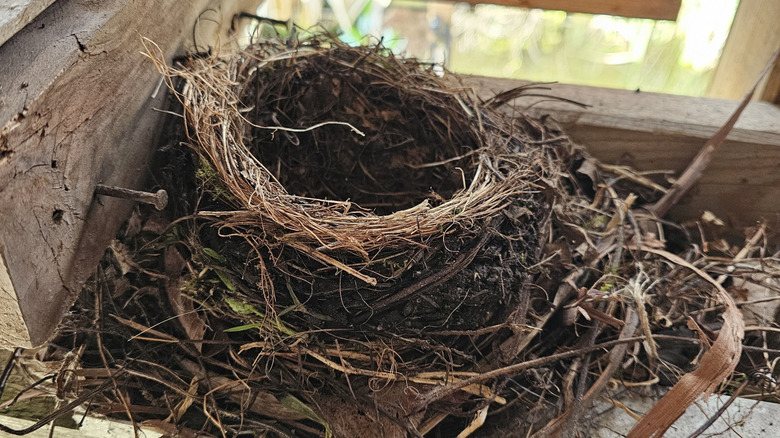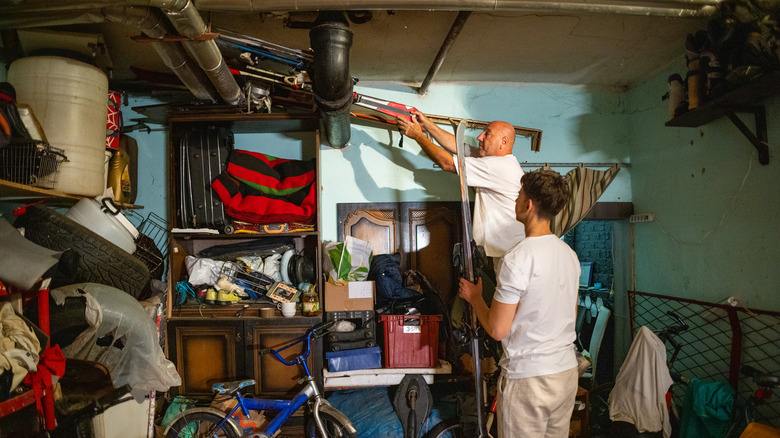Exactly What To Do When There's A Bird Nest In Your Garage
We may receive a commission on purchases made from links.
While you probably envision birds building their nests in trees, the reality can be very different. Several species of birds have a reputation for building their nests anywhere they perceive as safe, including on or inside buildings. Unfortunately, this can cause clashes between humans and avian visitors, particularly in urban and suburban areas where natural nesting sites may be challenging for birds to find. It's not uncommon to see birds nesting on patio pergolas or in the eaves of a porch. They're outdoors, and the feathered parents can generally be left alone. Finding a nest inside your garage is a more challenging proposition. You need to work out whether it's brand new, already contains eggs or chicks, or is abandoned, and possibly determine which species built it. The answers will determine whether you can remove the nest — or not — or even whether you need to contact the authorities.
Most bird species in the U.S. are protected. This means it's rarely legal to remove a wild bird's nest without a permit, regardless of where the birds choose to build their nest. The average nesting timeline for songbirds is about four weeks — from laying the eggs to when the chicks leave. You should leave active nests completely alone until this process is complete. You should also refrain from conducting any unnecessary activities around the nest that might disturb the birds and their young. That can be tricky to do if the nest is in your garage, where you store everything from sports equipment to your daily-use car. There is some hope. If the nest in your garage is incomplete and a bird family has yet to move in, you might still be able to remove it.
You can remove nest materials from a garage, but not active nests
Having to deal with a bird nest in your garage is far from unheard of; its presence presents unique challenges if the structure is enclosed. You want to keep your garage door closed for security and weatherproofing, but you don't want to trap any birds inside. The only time it's okay to remove a bird's nest is if you can't see any eggs, chicks, or adult birds on it. If you've determined the nest has just been built or is old and no longer in use, you might be able to carefully move the materials to a safe location outside the garage. Ideally, the spot should be within a few feet of your garage near the entrance. That way, any returning birds can find the materials and choose to keep using them, move them elsewhere, or abandon them.
On the other hand, if the nest is active, with eggs or birds in it, you cannot legally relocate it, no matter how inconvenient of a spot the birds have chosen. Relocating an active nest is not only against the law, but it's also detrimental to the birds. Parents frightened from a nest may not return. At this point, you need to wait for the nesting and fledging cycle to finish. It might be possible to get a removal permit from the U.S. Fish and Wildlife Service. However, these are rarely issued — only when nests pose a safety risk to property or people. Also, by the time you've filed a permit, the birds will likely have left the nest. If you're unsure whether a nest is inactive or in use, contact a local wildlife rehabilitation expert to ask for advice.
How to prevent birds from nesting in your garage
Typically, the process of building a nest and laying eggs can take several days, so you have a short window of opportunity to stop the process and move the materials. If you regularly keep your garage door open during the day, inspect the inside every day — or even multiple times a day — for bird activity. Check rafters, corners, and the back and top of shelving; use a bright torch if needed. This is especially important in the spring, when most species of birds are actively building nests. You should also thoroughly check your garage interior after the door has been left open for any length of time, whether on purpose or by accident.
To prevent birds nesting in your garage in the first place, only open your garage door when absolutely necessary. Don't leave it open for prolonged periods, either, especially if you're dealing with persistent or returning birds. There are ways to stop birds from nesting where you don't want them. You can install wire mesh and screens over rafters and corners, put bird spikes on ledges, fill any holes and cracks birds might be using to enter your garage, or mount decoys that resemble bird predators, like this HiAnifri Rotating Head Plastic Owl Decoy.


